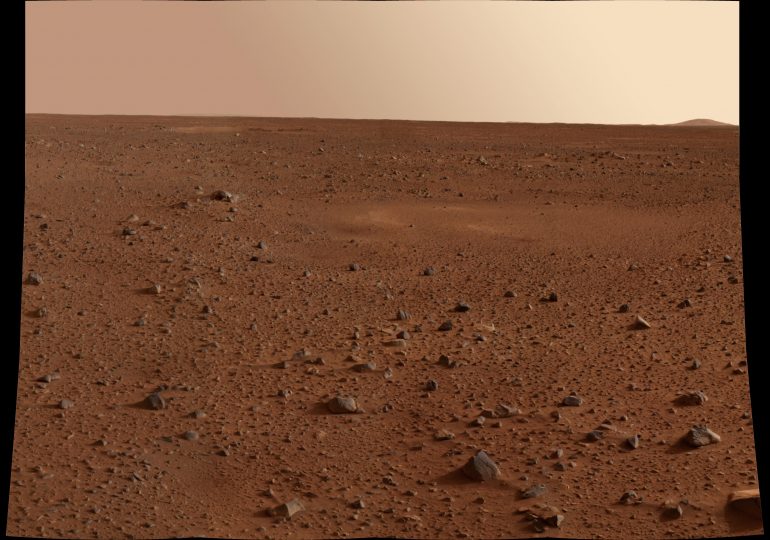Mars is a place of mysteries. Was it ever—or is it now—home to life? Why did it lose its magnetic field, allowing the solar wind to claw away its once-abundant atmosphere? And then there’s the riddle of the lost Martian water. As dry riverbeds, deltas, and ocean basins attest, the Red Planet once fairly sloshed with water—until three billion years ago, when it began turning into the desert world it is today. Two principal theories prevail for where all the water went: it either retreated into the ground or sublimed away into space. Now, a pair of papers—one released in August and another on Sept. 5—suggest that the answer is both.
[time-brightcove not-tgx=”true”]
The first study, published in the Proceedings of the National Academy of Sciences, relied on data from the Mars InSight spacecraft, which landed on Mars in 2018 and operated until 2022. InSight was equipped with a seismometer that measured multiple marsquakes in the four years the ship operated. It determined by the frequency of the vibrations that the energy was moving through a soggy subsurface, one that contained enough water to cover the entirety of Mars in an ocean about a mile deep. So case closed, right? Not so fast.
The new study, published in Science Advances, relied on data from two other venerable NASA spacecraft—the Hubble Space Telescope, which has been at work in Earth orbit since 1990, and the MAVEN orbiter, which has been circling Mars since 2014. Together, the ships gathered data about the Martian atmosphere dating back a decade for MAVEN and 33 years for Hubble. What they were both looking at was the escape of hydrogen to space—specifically two types of hydrogen: ordinary hydrogen, with a single proton in its nucleus, and heavier hydrogen, known as deuterium, with one proton and one neutron in its nucleus. Both types of atoms exist on Mars and on Earth, and both can be bound up in water molecules, with their single oxygen atom and their two hydrogen atoms.
In the Martian atmosphere, water molecules are broken down into their constituent atoms by ultraviolet energy streaming in from the sun. While most of the heavy oxygen atoms remain in the planet’s atmosphere, the same isn’t true for hydrogen. Both ordinary hydrogen and deuterium are lighter in weight, and can easily sputter away into space—but not equally: deuterium has a harder time breaking the bonds of Martian gravity due to the additional particle in its nucleus; light hydrogen streams right out. The new study, led by John Clarke, professor emeritus of astronomy at Boston University’s Center for Space Physics, used the MAVEN and Hubble observations to track the escape of both types of the hydrogen atom. This then allowed the authors to estimate how much water once covered the planet and how much of it could be accounted for by the loss to space.
But the work involved more than just extrapolating that data back over the three billion years it’s taken Mars to dry out. That’s because Mars’s orbit is an irregular thing.
Earth orbits the sun in a slightly uneven circle, keeping an average distance of 93 million miles. Mars’s orbit is much more elliptical—with an aphelion, or furthest remove from the sun, of 155 million miles and a perihelion, or closest approach, of 128 million miles. That dramatically changes the amount of water in the atmosphere throughout the year and, in turn, the amount of free hydrogen that can escape.
At aphelion, water has an abundance of less than one part per million in Mars’s skies, compared to more than 50 parts per million at perihelion. That, according to the Hubble and MAVEN data, translates to five to 20 times more water loss—and hydrogen loss—during the closest solar approach.
“In recent years, scientists have found that Mars has an annual cycle that is much more dynamic than people expected,” Clarke said in a statement that accompanied the release of the study. “The whole atmosphere is very turbulent, heating up and cooling down on short timescales, even down to hours. The atmosphere expands and contracts as the brightness of the sun at Mars varies by 40% over the course of a Martian year.”
That has consequences. Mars and Earth started out with the same ratio of deuterium to hydrogen in their water, but over the epochs that Mars has been drying, the greater loss of light hydrogen to space has thrown that ratio off. Modern-day Mars has up to eight times more deuterium relative to light hydrogen than does Earth—which retained its thick atmosphere and thus all of its water.
Running those numbers, Clarke and his co-authors estimate that of the mile-deep layer of water that may once have been the average across Mars, tens to hundreds of meters may have escaped to space. That still leaves the majority of the lost water trapped underground or locked up in polar ice caps, but plenty just drifted off too.
“There are only two places water can go,” Clarke said. “It can freeze into the ground or the water molecule can break into atoms, and the atoms can escape from the top of the atmosphere into space. To understand how much water there was and what happened to it, we need to understand how the atoms escape into space.”
Leave a comment








